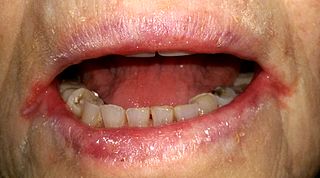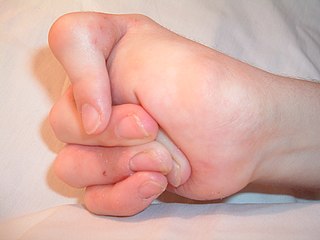| Microstomia | |
|---|---|
 | |
| Acquired microstomia from congenital syphilis | |
| Specialty | Medical genetics |
Microstomia is a small mouth (micro- a combining form meaning small + -stomia a combining form meaning mouth = (abnormally) "small mouth" in Greek.)
| Microstomia | |
|---|---|
 | |
| Acquired microstomia from congenital syphilis | |
| Specialty | Medical genetics |
Microstomia is a small mouth (micro- a combining form meaning small + -stomia a combining form meaning mouth = (abnormally) "small mouth" in Greek.)
It is a feature of many craniofacial syndromes, including Freeman–Sheldon syndrome and Sheldon-Hall syndromes (or distal arthrogryposis multiplex congenita). It may present with whistling-face feature, as well, as in Freeman-Sheldon syndrome. In this syndrome, it impairs alimentation and may require repeated oral surgeries (called commissurotomy) to improve function.[ citation needed ]
Microstomia can occur as a result of scarring due to many conditions. It is seen as complication of facial burns. [1] It can also be a feature of systemic scleroderma. [2]

Language is a structured system of communication that consists of grammar and vocabulary. It is the primary means by which humans convey meaning, both in spoken and written forms, and may also be conveyed through sign languages. The vast majority of human languages have developed writing systems that allow for the recording and preservation of the sounds or signs of language. Human language is characterized by its cultural and historical diversity, with significant variations observed between cultures and across time. Human languages possess the properties of productivity and displacement, which enable the creation of an infinite number of sentences, and the ability to refer to objects, events, and ideas that are not immediately present in the discourse. The use of human language relies on social convention and is acquired through learning.

A mouth ulcer (aphtha) is an ulcer that occurs on the mucous membrane of the oral cavity. Mouth ulcers are very common, occurring in association with many diseases and by many different mechanisms, but usually there is no serious underlying cause. Rarely, a mouth ulcer that does not heal may be a sign of oral cancer. These ulcers may form individually or multiple ulcers may appear at once. Once formed, an ulcer may be maintained by inflammation and/or secondary infection.

Oral candidiasis, also known as oral thrush among other names, is candidiasis that occurs in the mouth. That is, oral candidiasis is a mycosis of Candida species on the mucous membranes of the mouth.

Xerostomia, also known as dry mouth, is dryness in the mouth, which may be associated with a change in the composition of saliva, or reduced salivary flow, or have no identifiable cause.

Stomatitis is inflammation of the mouth and lips. It refers to any inflammatory process affecting the mucous membranes of the mouth and lips, with or without oral ulceration.

The inferior labial frenulum, or frenulum labii inferioris. is the frenulum connecting the lower gums with the lower lip.

Angular cheilitis (AC) is inflammation of one or both corners of the mouth. Often the corners are red with skin breakdown and crusting. It can also be itchy or painful. The condition can last for days to years. Angular cheilitis is a type of cheilitis.

Meige's syndrome is a type of dystonia. It is also known as Brueghel's syndrome and oral facial dystonia. It is actually a combination of two forms of dystonia, blepharospasm and oromandibular dystonia (OMD).

Otocephaly, also known as agnathia–otocephaly complex, is a very rare and lethal cephalic disorder characterized by the absence of the mandible (agnathia), with the ears fused together just below the chin (synotia). It is caused by a disruption to the development of the first branchial arch. It occurs in every 1 in 70,000 embryos.

Freeman–Sheldon syndrome (FSS) is a very rare form of multiple congenital contracture (MCC) syndromes (arthrogryposes) and is the most severe form of distal arthrogryposis (DA). It was originally described by Ernest Arthur Freeman and Joseph Harold Sheldon in 1938.
Hypopnea is overly shallow breathing or an abnormally low respiratory rate. Hypopnea is defined by some to be less severe than apnea, while other researchers have discovered hypopnea to have a "similar if not indistinguishable impact" on the negative outcomes of sleep breathing disorders. In sleep clinics, obstructive sleep apnea syndrome or obstructive sleep apnea–hypopnea syndrome is normally diagnosed based on the frequent presence of apneas and/or hypopneas rather than differentiating between the two phenomena. Hypopnea is typically defined by a decreased amount of air movement into the lungs and can cause oxygen levels in the blood to drop. It commonly is due to partial obstruction of the upper airway.

Sialolithiasis is a crystallopathy where a calcified mass or sialolith forms within a salivary gland, usually in the duct of the submandibular gland. Less commonly the parotid gland or rarely the sublingual gland or a minor salivary gland may develop salivary stones.

In animal anatomy, the mouth, also known as the oral cavity, or in Latin cavum oris, is the opening through which many animals take in food and issue vocal sounds. It is also the cavity lying at the upper end of the alimentary canal, bounded on the outside by the lips and inside by the pharynx. In tetrapods, it contains the tongue and, except for some like birds, teeth. This cavity is also known as the buccal cavity, from the Latin bucca ("cheek").

DOCK8, also known as Zir3, is a large protein involved in intracellular signalling networks. It is a member of the DOCK-C subfamily of the DOCK family of guanine nucleotide exchange factors (GEFs) which function as activators of small G proteins.
Oral and maxillofacial pathology refers to the diseases of the mouth, jaws and related structures such as salivary glands, temporomandibular joints, facial muscles and perioral skin. The mouth is an important organ with many different functions. It is also prone to a variety of medical and dental disorders.

The G-Man is a mysterious recurring character and one of the main antagonists in the Half-Life series of first-person shooter video games. Described as a "sinister, interdimensional bureaucrat", he is known to display peculiar behavior and capabilities beyond those of normal humans.

Salivary gland diseases (SGDs) are multiple and varied in cause. There are three paired major salivary glands in humans – the parotid glands, the submandibular glands, and the sublingual glands. In addition there are about 800-1000 minor salivary glands in the mucosa of the mouth. The parotid gland is located in front of each ear, and secretes mostly serous saliva via the parotid duct into the mouth, usually opening roughly opposite the maxillary second molar. The submandibular gland is located medial to the angle of the mandible, and it drains its mixture of serous and mucous saliva via the submandibular duct into the mouth, usually opening in a punctum located in the floor of mouth. The sublingual gland is located below the tongue, on the floor of the mouth. It drains its mostly mucous saliva into the mouth via about 8-20 ducts which open along the plica sublingualis.
Autoimmune autonomic ganglionopathy (AAG) is a rare form of dysautonomia in which the immune system produces ganglionic anti-nicotinic acetylcholine receptor (AChR) antibodies, inhibiting ganglionic AChR currents and impairing transmission in autonomic ganglia. Symptoms onset can be acute, subacute or gradual.

A nonmanual feature, also sometimes called nonmanual signal or sign language expression, are the features of signed languages that do not use the hands. Nonmanual features are gramaticised and a necessary component in many signs, in the same way that manual features are. Nonmanual features serve a similar function to intonation in spoken languages.
Fine-Lubinsky syndrome is a rare genetic disorder which is characterized by ocular and hearing problems, speech and developmental delay, short stature, intellectual disabilities and facial dysmorphisms.